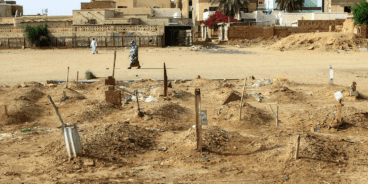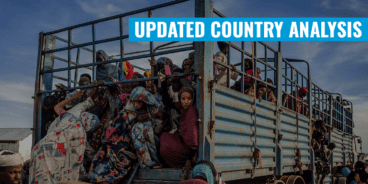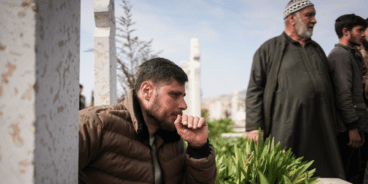
On R2P, America Takes the Lead
The following article written by Thomas G. Weiss was originally published in Current History, Volume: 111, Issue: 748.
Determining whether, when, where, and why to intervene to protect civilians caught in the crosshairs of war and violence increasingly is guided by the “responsibility to protect” (R2P). With the exception of Polish attorney Raphael Lemkin’s advocacy for the 1948 Genocide Convention, no idea in the international normative arena has moved faster or farther in such a short time. First formulated in a 2001 report by the International Commission on Intervention and State Sovereignty, R2P has, according to friends and foes alike, reframed sovereignty as contingent rather than absolute. The commissioners aimed to halt mass atrocities by invoking a three-pronged responsibility: to prevent, react, and rebuild.
Since then we have seen not too much but rather too little humanitarian intervention. Indeed, the United Nations Security Council’s March 2011 sanctioning of international military action against Libya represented the first such authorization against a functioning de jure government. Between NATO’s 1999 intervention in Kosovo and Libya last year, the sharp end of the R2P stick—the use of military force—had been replaced by skittishness from diplomats, UN staff, scholars, and policy analysts.
The loss of life and suffering in Syria today are higher than they were in Libya, yet the paralysis amid the killings and atrocities committed by Bashar al-Assad’s regime suggests, in case there was any doubt, that robust action in one crisis does not necessarily foreshadow similar efforts elsewhere. Inconsistency is not only the hobgoblin of little minds but also the proverbial bottom line for political decision making. Talk is cheap, action is not.
Even so, the substantial normative and policy gains of the past decade are here to stay, in spite of the gnashing of Russian, Chinese, and others’ diplomatic teeth. Humanitarian intervention remains squarely on the foreign policy agenda, in Washington and other capitals. The intergovernmental agreement on the occasion of the UN’s 60th anniversary at the 2005 World Summit to halt “genocide, war crimes, ethnic cleansing, and crimes against humanity” marked a turning point in R2P’s crystallization—though not quite the “international Magna Carta” hyperbolically proclaimed by the State Department’s former director of policy planning, Anne-Marie Slaughter.
Realizing the Idea
Organizations are not the answers to all our prayers, but norms have more clout once they are embedded in structures with resources and personnel dedicated to fostering the realization of an idea. In 2010 the UN created a joint office for R2P and the prevention of genocide. Meanwhile, a number of countries have established focal points to begin internalizing R2P at the national level.
The most significant of these has arisen in the United States, the result of a presidential study directive by the Barack Obama administration. This initiative, and the decision to act in Libya, emanated from a “dream team” of genocide prevention: Secretary of State Hillary Rodham Clinton, UN Ambassador Susan Rice, and Special Assistant to the President Samantha Power. As a result, in August 2011, President Obama established the Atrocity Prevention Board (APB)—an interagency mechanism to facilitate rapid reaction across the US government to prevent mass atrocities.
“Our security is affected when masses of civilians are slaughtered, refugees flow across borders, and murderers wreak havoc on regional stability and livelihoods,” Obama stated when unveiling the initiative. “America’s reputation suffers, and our ability to bring about change is constrained, when we are perceived as idle in the face of mass atrocities and genocide.”
The APB actually gathered for the first time at the White House on April 23, 2012, coinciding with the annual remembrance of the Holocaust. Sixty-seven years after the end of that tragedy and eighteen after the beginning of Rwanda’s nightmare, the president announced that the United States would produce a National Intelligence Estimate of the potential for mass atrocities around the world. Obama mentioned that the initiative was part of his administration’s efforts at “institutionalizing” how the US government mobilizes to prevent and halt mass atrocities. The White House highlighted a strategy in which the prevention of such crimes was not only a moral responsibility but a core national security interest as well.
Risk and Reward
In thinking about future policy options, it would be foolish to overlook or discount five risks associated with deploying force to protect civilians. First, the intervention may be premature and not give other coercive but non-forcible measures such as sanctions the chance to work. Second, it may do more harm than good, and the unintended consequences (sometimes euphemistically labeled “collateral damage”) may outweigh the benefits of deploying military assets. Third, those applying force may exceed the terms of an approved mandate; the dispute over the authorized extent of NATO action in Libya is one illustration. Fourth, military force may fail if an operation is performed poorly, and such failure may threaten the future application of the R2P norm. A related complication is blowback (after the deaths of US soldiers in Somalia in 1993, for instance) that may compromise future decisions about preventing or halting mass atrocities (in Rwanda in 1994, for instance). Fifth, the unpredictable aftermath of military force and the inevitable difficulties of postconflict peace-building may also color future perceptions of the norm.
While these criticisms have all been leveled by some observers in the aftermath of the Libya intervention, it also would be shortsighted to ignore the four main risks from not using military force when mass atrocities threaten. First and foremost, catastrophic suffering could occur, suffering of exactly the type that, since the Holocaust, the international community of states has continually pledged to allow “never again.” Second, states would once again shame themselves and make a mockery of a substantial body of public international law by looking the other way in the face of mass murder. Third, if coercive force is postponed and displaced persons and revenge killings mount, options are reduced and the potential costs of deploying military assets later could up the ante to such an extent as to preclude taking action. Fourth, the demonstration effect of spinelessness could send the wrong message to other would-be thugs, and the deterrent effects of future international diplomacy could be weakened.
No task is more fraught than a decision to deploy military force. When the United States considers humanitarian intervention, the main policy options would follow from an APB risk analysis with answers to the following questions. First, have Americans moved beyond the “Somalia syndrome” and the apparent necessity for zero casualties among US soldiers in coming to the rescue, no matter how many victims are saved? Second, have prudential considerations been given their due, and are the imagined benefits of averted atrocities (which involve counterfactual speculation) persuasive enough to outweigh the far more visible destructiveness of a military intervention? Third, does an exit strategy address “mission creep,” because the requirements for terminating a mission, including postconflict peace-building, inevitably are more ambitious than the initial aim to avert or halt mass atrocities? Fourth, are there plausible responses for the inevitable criticisms of inconsistency across other cases where intervention did not or cannot occur? And finally, is there a plan for military burden sharing and diplomatic support from regional organizations?
The last question entered into the equation with Libya, and provides new elements circumscribing future policy options when humanitarian rather than vital national interests are on the line. The scorned notion of “leading from behind” actually meant, in the case of Libya, complementing US military assets with those from NATO partners backed by regional diplomatic support from the Arab League, the Gulf Cooperation Council, and the African Union. The United States remained essential: NATO allies still depended on American precision munitions, refueling aircraft, and reconnaissance. However, with massive budget cuts looming, future military action for human protection purposes will require comparable pooling of resources; and the politics of mobilizing regional support will require multilateral cooperation. “Perhaps it’s better understood as leading without wishing to be seen as taking the lead,” muses the New York Times Magazine’s James Traub: “a new model of multilateralism suitable to a posthegemonic era.”
Truth and Power
US participation in the Libya intervention has proved one of the few signature successes of the administration’s foreign policy. Speaking in Brazil after imposing the no-fly zone, Obama saw no contradiction with his Nobel Peace Prize—one can favor peace but still authorize force to halt the “butchering” of civilians. The president’s decision provided no political advantage, but it prevented massacres that would have, in his words, “stained the conscience of the world.”
One hopes Libya was not an aberration. Americans desperately need to rediscover the passion and commitment of Bill Clinton’s mea culpa after the Rwanda tragedy. Are leaders capable of pledging no more Holocausts, Cambodias, or Rwandas—and occasionally meaning it?
“Never again” is not a reality, but US leadership makes it a plausible proposition. Politics and military capacity ultimately determine whether, when, where, and why to protect and assist war-affected populations. However shocking to the conscience a particular emergency, and however hard or soft the applicable international law, when political will and a military capacity exist, humanitarian space will open and war victims will be assisted and protected. In Libya the moral, legal, political, and military dimensions dovetailed under the R2P rubric. Rather than speaking truth to power, the value of R2P was speaking truth with power. And if Assad leaves Syria, it will in part be attributable to the evolving power of the R2P norm.
Related Content


Populations at Risk, March 2025
